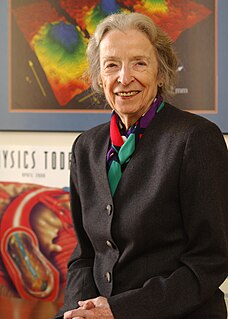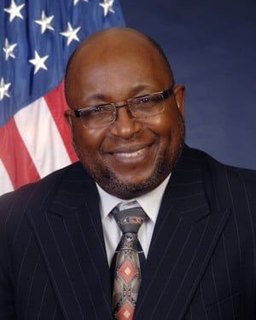
The American National Standards Institute is a private non-profit organization that oversees the development of voluntary consensus standards for products, services, processes, systems, and personnel in the United States. The organization also coordinates U.S. standards with international standards so that American products can be used worldwide.
Conversion of units is the conversion between different units of measurement for the same quantity, typically through multiplicative conversion factors.
Federal Information Processing Standards (FIPS) are publicly announced standards developed by the United States federal government for use in computer systems by non-military government agencies and government contractors.

The litre or liter is an SI accepted metric system unit of volume equal to 1 cubic decimetre (dm3), 1,000 cubic centimetres (cm3) or 1/1,000 cubic metre. A cubic decimetre occupies a volume of 10 cm×10 cm×10 cm and is thus equal to one-thousandth of a cubic metre.
The metre or meter is the base unit of length in the International System of Units (SI). The SI unit symbol is m. The metre is defined as the length of the path travelled by light in vacuum in 1/299 792 458 of a second.
A physical constant, sometimes fundamental physical constant or universal constant, is a physical quantity that is generally believed to be both universal in nature and have constant value in time. It is contrasted with a mathematical constant, which has a fixed numerical value, but does not directly involve any physical measurement.
The Malcolm Baldrige National Quality Award recognizes U.S. organizations in the business, health care, education, and nonprofit sectors for performance excellence. The Baldrige Award is the only formal recognition of the performance excellence of both public and private U.S. organizations given by the President of the United States. It is administered by the Baldrige Performance Excellence Program, which is based at and managed by the National Institute of Standards and Technology (NIST), an agency of the U.S. Department of Commerce.
Joan Daemen is a Belgian cryptographer who co-designed the Rijndael cipher with Vincent Rijmen, which was selected as the Advanced Encryption Standard (AES) in 2001. More recently, he co-designed the Keccak cryptographic hash, which was selected as the new SHA-3 hash by NIST in October 2012.
He has also designed or co-designed the MMB, Square, SHARK, NOEKEON, 3-Way, and BaseKing block ciphers. In 2017 he won the Levchin Prize for Real World Cryptography "for the development of AES and SHA3".
The rad is a unit of absorbed radiation dose, defined as 1 rad = 0.01 Gy = 0.01 J/kg. It was originally defined in CGS units in 1953 as the dose causing 100 ergs of energy to be absorbed by one gram of matter. The material absorbing the radiation can be human tissue or silicon microchips or any other medium.
Ronald Collé is a specialist in nuclear and radiochemistry, radionuclidic metrology, and the development of standards. He has worked at the National Institute of Standards and Technology (NIST) from 1976 to 2003 and from 2005 to present, and currently serves as a Research Chemist in the Radioactivity Group of the NIST Physics Laboratory.
The Process Specification Language (PSL) is a set of logic terms used to describe processes. The logic terms are specified in an ontology that provides a formal description of the components and their relationships that make up a process. The ontology was developed at the National Institute of Standards and Technology (NIST), and has been approved as an international standard in the document ISO 18629.
NIST is a method for evaluating the quality of text which has been translated using machine translation. Its name comes from the US National Institute of Standards and Technology.

William A. Jeffrey is the CEO of SRI International, a position he has held since September 2014.
The Digital Library of Mathematical Functions (DLMF) is an online project at the National Institute of Standards and Technology to develop a major resource of mathematical reference data for special functions and their applications. It is intended as an update of Abramowitz's and Stegun's Handbook of Mathematical Functions (A&S). It was published online on May 7, 2010, though some chapters appeared earlier. In the same year it appeared at Cambridge University Press under the title NIST Handbook of Mathematical Functions.
The siemens is the derived unit of electric conductance, electric susceptance, and electric admittance in the International System of Units (SI). Conductance, susceptance, and admittance are the reciprocals of resistance, reactance, and impedance respectively; hence one siemens is redundantly equal to the reciprocal of one ohm, and is also referred to as the mho. The 14th General Conference on Weights and Measures approved the addition of the siemens as a derived unit in 1971.

Patrick David Gallagher is an American physicist and the eighteenth chancellor of the University of Pittsburgh. He was formerly the 14th director of the U.S. Department of Commerce's National Institute of Standards and Technology (NIST) and had served as the Acting United States Deputy Secretary of Commerce. On February 8, 2014, he was named the Chancellor-elect of the University of Pittsburgh and assumed the position of Chancellor on August 1, 2014.

Katharine Blodgett Gebbie was an American astrophysicist and civil servant. She was the founding Director of the Physical Measurement Laboratory of the National Institute of Standards and Technology (NIST), and of its two immediate predecessors, the Physics Laboratory and the Center for Atomic, Molecular and Optical Physics, both for which she was the only Director. During her 22 years of management of these institutions, four of its scientists were awarded the Nobel Prize in Physics. In 2015, the NIST Katharine Blodgett Gebbie Laboratory Building in Boulder, Colorado was named in her honor.

Willie E. May is an American chemist who was director of the United States' National Institute of Standards and Technology (NIST) and the U.S. Under Secretary of Commerce for Standards and Technology. He has been active in international organizations, collaborating with others in Brazil, China, and the European Union.






